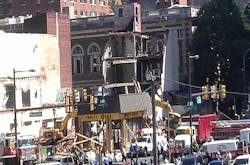I think it’s time that we, as a society, started demanding that employers and contractors who knowingly cause or contribute to deadly workplace incidents automatically be charged with murder or manslaughter.
Griffin Campbell is a contractor who was hired to demolish a four-story building in Philadelphia. He agreed to a tight time frame and a flat fee for the work. He also got to salvage any of the materials he wanted from the demolished building.
It appears in order to save money and remove the most valuable materials before they could be damaged in the demolition process, he ordered that support beams and most of the infrastructure supporting the walls be removed first, leading to a catastrophic collapse that killed six people in the building next door and injured 14 others.
Yesterday, Philadelphia District Attorney Seth Williams charged him with six counts of third-degree murder, six counts of manslaughter and a host of other crimes. I was astonished in a good way, because murder charges RARELY are filed in cases like this and it usually falls to a local prosecutor to file them since cases referred by OSHA to the U.S. Department of Justice usually go nowhere.
As a contractor doing this type of work – or even as an average person with a lick of sense – Campbell knew that removing interior support beams without providing any kind of bracing for the outside walls could result in a catastrophic collapse of the building. He also knew or should have known that standard demolition practice for this type of building called for floor-by-floor demolition, not gutting the interior of the building.
Campbell was conducting business with money – not safety – on his mind: the money he would make for finishing the job on time and on budget and through salvaging building materials.
Safety didn’t enter his mind while he was planning the job, placing a bid that caused him to worry that he would not be able to make money AND demolish the building safely. It didn’t enter his mind as his crews and subcontractors, like Kary Roberts (a.k.a. Sean Benschop), were operating heavy equipment around destabilized walls. It didn’t enter his mind when Roberts allegedly showed up for work high on the day of the collapse. (Toxicology tests taken the day of the collapse reported the presence of controlled substances in Robert’s blood.)
It didn’t enter his mind when the architect on the project warned him the day before the collapse that the situation was dire and that he MUST brace the walls of the building immediately. It didn’t enter his mind when he lied to the architect and told him that the walls had been braced. It didn’t enter his mind when the walls collapsed.
Roberts knowingly operated in an unsafe manner and in doing so, sacrificed the lives of six victims. The same could be said of BP and its contractors in the Deepwater Horizon incident or the Texas City incident. Yes, the company paid multimillion and even billion dollar fines for those deadly incidents, but no one at the top – the “deciders” – went to prison despite dozens of deaths and evidence that systemic failures and poor (a.k.a. profit- and cost-focused) decision-making starting at the very top of the corporate foodchain contributed to those deaths.
What about the West, Texas explosion that killed 14 and injured 160? This sounds so simple as to be stupid, but safe facilities following industry best practices and OSHA and EPA regulations that have well-trained workers don’t blow up.
What about the Upper Big Branch mining disaster that killed 29 miners? Some former Massey Energy employees were convicted of criminal activity in that case and have gone to prison. But the big fish, former CEO Don Blankenship, was never charged with a crime. He knew that in the five years before the explosion at the mine, MSHA issued a total of 1,342 safety violations for the mine, proposing $1.89 million in fines. We know Blankenship knew about these violations because he contested them and kept them tied up in court thanks to loopholes in MSHA regulations. He knew his mine was unsafe, and he didn’t care and so far, no one has made him care.
It's been proved, time and time again for certain companies, that large OSHA and EPA fines are not a deterent to condoning unsafe work practices and creating unsafe workplaces. If they were, we'd never see companies receiving repeat violations. Maybe jail time for those responsible would be a deterent.
I hope that this Philadelphia case sets a precedent for the entire country. The year is 2013. It's time that employers no longer consider deaths or injuries (or, for that matter, OSHA, MSHA or EPA fines) as part of the cost of doing business.
About the Author
Sandy Smith Blog
Content Director
Sandy Smith is content director of EHS Today. She has been writing about occupational safety and health and environmental issues since 1990. She has been interviewed about occupational safety and health for national business publications,documentaries and television programs, has served as a panelist on roundtables, has provided the keynote address for occupational safety and health conferences and has won national and international awards for her articles.
